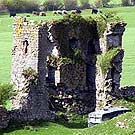Gleaston Castle

Base layers
Data layers

Other Images
Venue Type & Location
Site Name: Gleaston Castle
Location: near Furness
County: Lancashire
Location Type: Town - near town at determined location
Overview
Situated in a fertile valley near the sea on the Furness peninsula in the historic county of Lancashire (now Cumbria).
The site has been ruinous for centuries, but was once a medieval fortified castle built on a quadrangle with limestone curtain walls and 4 corner towers. Remains of the keep, built on the highest point, stand at the NW corner. The entrance to the hall in this residential tower was on the S side.
The hall was 30' by 22', lit from the S (VCH Lanc 8.322). Above it were 2 storeys, each containing 4 rooms accessed by a stone staircase at the NE corner of the hall.
Performance History
A possible performance venue. Although household accounts for the Harington residences do not survive, there is evidence that William, the 5th Baron, patronized minstrels who toured elsewhere. It is possible that they performed at Gleaston for their lord.
Current Status
A Grade I listed ruin, easily viewed from a distance but dangerous to explore.
History of the Venue
1293 John de Haverington, 1st Baron Harington, inherited Aldingham or Muchland Manor (including Gleaston) from his mother.
early 14th c. Castle built by John, 2nd Baron Harington (1328--1363).
1458 Abandoned as a residence after the death of William, 5th Baron Harington, and dismantled, falling rapidly into decay.
ca. 1540 Ruinous by the time of John Leland's visit (Itinerary 5.222).
Record Source
REED York 1.70--1, 76
Patrons who owned this venue
| Name | Dates | Titles |
|---|---|---|
| Harington, William | 1389-1458 | 5th Baron |
| Hill, Margaret | 0-1458 | Lady |
Bibliographic Sources
-
Buck, Samuel, and Nathaniel Buck. [A Collection of Engravings of the Castles, Abbeys, and Towns in England and Wales]. 5 vols. London: The authors, 1726–52.
-
Curwen, John F. The Castles and Fortified Towers of Cumberland, Westmorland and Lancashire North-of-the-Sands. Cumberland and Westmorland Antiquarian and Archaeological Society, es. Kendal: Titus Wilson, 1913.
-
King, David J. Cathcart. Castellarium Anglicanum: An Index and Bibliography of the Castles in England, Wales and the Islands. 2 vols. Millwood, NY, London and Nendeln, Liechtenstein: Kraus International Publications, 1983.
-
Mackenzie, James D. The Castles of England: Their Story and Structure. 2 vols. New York: The Macmillan Co., 1896.
-
Oxford Dictionary of National Biography. 01/05/2005 (http://www.oxforddnb.com)
-
Perriam, D.R., and J. Robinson. The Medieval Fortified Buildings of Cumbria: An Illustrated Gazetteer and Research Guide. Cumberland and Westmorland Antiquarian and Archaeological Society, es. Kendal: Cumberland and Westmorland Antiquarian and Archaeological Society, 1998.
-
Pettifer, Adrian. English Castles: A Guide by Counties. Woodbridge: The Boydell P, 1995.
-
Pevsner, Nikolaus. Lancashire: The Rural North. The Buildings of England. Harmondsworth, Midd: Penguin Books, 1969.
-
Somerset Fry, Plantagenet. Castles of the British Isles. New York: Dorset P, 1990.
-
The Victoria History of the County of Lancaster. The Victoria History of the Counties of England. 8 vols. London: Archibald Constable, 1906–14.



